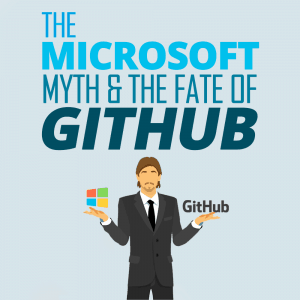
Why is this such big news? To get into that, we have to look at Microsoft’s history. For a long time, Microsoft had a negative reputation as being a closed shop, so to speak, and not being developer-friendly. The negative attitude that Microsoft had toward open source software (OSS) development (particularly the Linux development community) was revealed in a leaked internal memo that was widely circulated in 1998.
Clearly, Microsoft felt that their dominant market position was threatened by Linux and the open source community. This attitude, along with Microsoft’s near-monopoly position, and related wranglings with the U.S. Justice Department, made it clear that OSS would never be welcome at Microsoft.
That’s why its acquisition of GitHub may have been an unwelcome surprise.
To this day, there are members of the software development community who very much dislike Microsoft. But this sentiment is from 20 years ago. Is the negative reputation toward Microsoft among some people still deserved?
Let’s examine what Microsoft has been doing with and for developers lately.
In 2015, Microsoft launched Visual Studio Code, a free version of their full Visual Studio product. It’s an Integrated Development Environment (IDE). While it is slimmed down, the capabilities of Visual Studio Code can be enhanced with the many extensions available for it. And many of these extensions are developed by community members, much the way OSS is improved on, iteration after iteration.
Visual Studio Code is now the most popular IDE, according to the 2018 Stack Overflow Developer Survey.
Microsoft has recently contributed to significant open source projects, such as Node.js. The company also purchased Xamarin, a platform for developing mobile apps on both iOS and Android; Microsoft then open-sourced the Xamarin SDK (Software Development Kit). You can read John Sonmez’s post about Xamarin.Forms here, and you can read Jason Lowenthal’s post on why to contribute to open source projects here.
Why?
So why? Why did Microsoft start shifting away from its reputation as a monolithic, proprietary, and allegedly monopolistic company? Why the about-face to open-source-loving, community-driven, and sharing? Why the purchase of GitHub?
One key reason is Microsoft’s new leadership.
In 2014, Satya Nadella succeeded Steve Ballmer as CEO of the company. Before becoming the Microsoft CEO, Nadella was a key figure in developing Microsoft’s cloud infrastructure and services. Nadella was highly influenced by his time spent working in the cloud computing field. Seeing as most Apache servers run Linux, Nadella would have pressed Microsoft to accept open source and Linux.
Nadella’s influence has led to a Microsoft that is no longer primarily an operating system/software company. Instead, it’s now primarily a cloud company. In Q4 2015, approximately 20 percent of Microsoft’s revenues came from its cloud service, Azure. While Microsoft does have revenue from other sources, cloud services are the single largest source of Microsoft’s revenues.
In Q3 2017, Microsoft reported that Azure revenue grew by 93 percent: Azure revenues, as reported, were $15.2 billion at that point.
It’s hard to miss where Microsoft needs to direct its energies if its wants to keep making this kind of money in the future.
The GitHub Strategy
It seems apparent now that Microsoft is much friendlier toward developers and the idea of open source products than in previous years. And it looks like they’re more of a cloud company than anything else. Still, what’s the strategy behind buying GitHub? Microsoft is no nonprofit, looking to help the open source community. GitHub makes $110 million annually, and while that is not an insignificant amount for a small company, it’s peanuts compared to Microsoft’s annual revenues.

Instead of just reacting to open source and Linux, Microsoft has developed a nurturing strategy for open-source-inclined developers. It’s essentially been a steady drip campaign of development and influence. Promoting goodwill and providing value can be a very compelling marketing strategy—this type of behavior is much better received than that of punitive measures and combativeness.
This is the new era of Microsoft.
The Future
These are interesting and immensely rewarding times for Microsoft, and the company is looking to invest in the future. In addition to leveraging their cloud infrastructure to power SaaS platforms such as Office 365 for business consumers, Microsoft is eyeing future trends. Products using the hybrid cloud (a mix of data center and on-premises hardware), artificial intelligence, and the Internet of Things could all be in its line of sight.
Microsoft’s plan seems to be to make itself an indispensable service provider for major developers and enterprise alike. Heralded by its embrace of things it once rejected, the GitHub purchase cements Microsoft’s new era.
